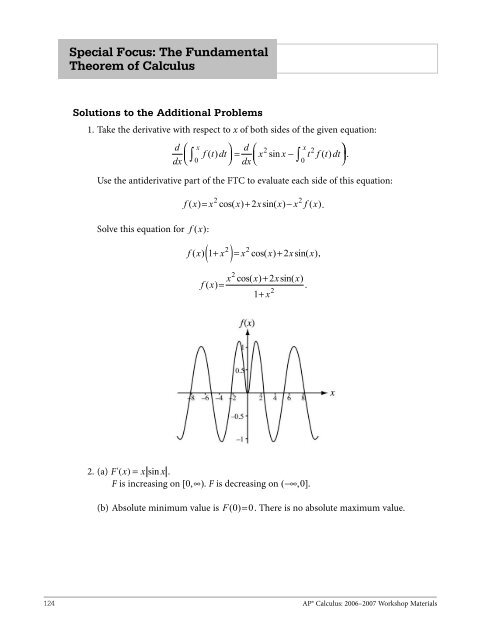AP Calculus
You also want an ePaper? Increase the reach of your titles
YUMPU automatically turns print PDFs into web optimized ePapers that Google loves.
Special Focus: The Fundamental<br />
Theorem of <strong>Calculus</strong><br />
Solutions to the Additional Problems<br />
1. Take the derivative with respect to x of both sides of the given equation:<br />
d ⎛<br />
dx ⎝<br />
⎜<br />
⎞ d ⎛<br />
f t dt<br />
dx x 2 x x<br />
( ) sin t 2<br />
f ( t )<br />
⎠<br />
⎟ = −<br />
⎝<br />
⎜<br />
dt ⎞<br />
⎠<br />
⎟ .<br />
x<br />
∫ 0<br />
∫ 0<br />
Use the antiderivative part of the FTC to evaluate each side of this equation:<br />
2 2<br />
f ( x) = x cos( x) + 2 xsin( x) − x f ( x)<br />
.<br />
Solve this equation for f ( x):<br />
f ( x) ( 1+<br />
x 2 )= x 2 cos( x) + 2xsin( x)<br />
,<br />
2<br />
x cos( x) + 2xsin( x)<br />
f ( x)<br />
=<br />
.<br />
2<br />
1+<br />
x<br />
2. (a) F'( x) = x sin x .<br />
F is increasing on [ 0, ∞ ). F is decreasing on ( −∞, 0 ].<br />
(b) Absolute minimum value is F( 0)<br />
= 0. There is no absolute maximum value.<br />
124<br />
<strong>AP</strong>® <strong>Calculus</strong>: 2006–2007 Workshop Materials


